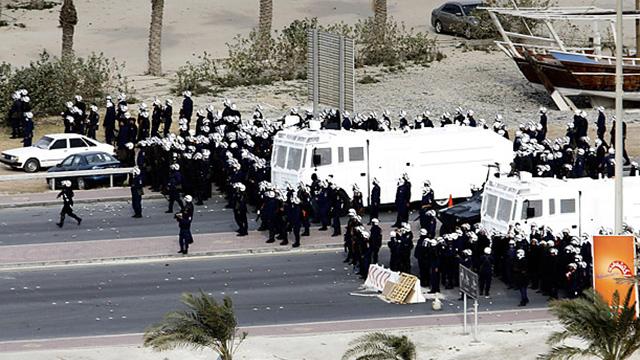
In the 1990s, there was an animated SNL sketch called “Divertor” that featured a superhero whom governments depended on to distract the news outlets from covering critically important issues. In one part of the sketch, Divertor causes comedian Sinbad to expose himself to a classroom full of children just as news is breaking about high unemployment numbers.
The news of the last two weeks has been dominated by the repetitive soap opera of the Manti Te’o fake girlfriend hoax, Lance Armstrong’s admission of doping to Oprah, and Beyonce lip-synching the national anthem at the inauguration. And in the midst of all the trumped-up silliness and dead horse-beating of the aforementioned non-stories in the media, the news of the U.S. government aiding in Bahrain’s brutal crackdown of nonviolent pro-Democracy protests has gone completely unnoticed.
U.S.-backed Bahrain is one of the lesser-known nations where the Arab Spring movement took off, putting millions in the streets since early 2011. Like other Middle Eastern nations in the midst of revolution, such as Egypt and Syria, that government has responded to protesters with aggressive, bloody force. Now, the technology and material origins of that force should be causing Americans to sit up and take notice.
The New York Times reported on American helicopters being used to fire on Bahraini protesters, while Time magazine wrote of Cobra helicopters conducting “live ammunition airstrikes” on civilians there. While much of the American media was caught up in an attention-hungry jock’s potential NFL draft, ProPublica released Defense Department documents confirming at least $1.4 billion since 2000 in U.S. sales of ammunition, missile systems, helicopters and even training to the Bahraini government.
Of course, Big Media has also been in on the suppression of news in general about the Bahraini protests. CNN International reporter Amber Lyon was fired after complaining to her editors that a documentary on the protests and the government’s response had been heavily edited to favor the government’s official narrative. While a segment is available online, the full documentary was never broadcast on CNN International despite its $100,000 budget. The U.S.-supported regime frequently complained about Lyon’s coverage until her editors told her she had to include known fabrications from government officials in her report.
In the movie “Good Night and Good Luck,” Edward R. Murrow coldly warned the president of CBS that if news coverage was driven by what was most pleasing to the companies that bought ads, the media would become complicit in the erosion of democracy. Contrast that with today, where NBC News is covering J. Crew’s retirement of the coat Malia Obama was wearing at the inauguration, while PBS Frontline's recent documentary about the financial corruption that led to a DOJ official's resignation is a blip on the radar.
News used to be seen as an obligation to the public mandated by the FCC—for every few hours of programming, networks had to broadcast a proportional amount of news in the interest of democracy. But since the advent of sensationalized 24-hour cable news channels, shouting and brazen partisanship is rewarded while good journalism is relegated to the public sector.
MSNBC, CNN and FOX are at each other’s throats for ratings and ad revenue, while PBS is subject to relentless attacks on its budget. We could alleviate this wagging of the dog by doing what the Canadian Radio and Television Commission did: include a clause in broadcasting regulations that makes it “illegal to broadcast lies and call it news.”
Until then, the next time you see an unusual amount of coverage over a story with little to no meaningful impact, it probably wouldn’t hurt to check your bullshit-o-meter and look for the real news that’s being covered up.
3 WAYS TO SHOW YOUR SUPPORT
- Log in to post comments











